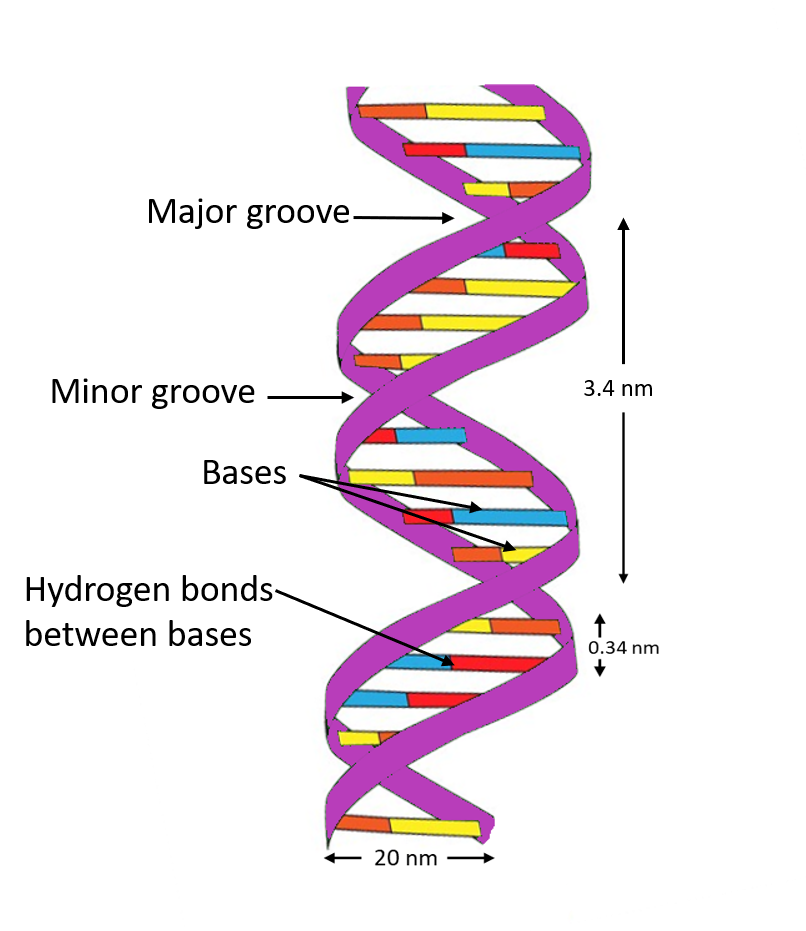
The helical structure of a protein is stabilized by
(a)Dipeptide bonds
(b)Hydrogen bonds
(c)Ether bonds
(d)Peptide bonds
Answer
480k+ views
Hint: The helical structure of the protein is stabilized by a type of bond that is usually formed between highly electronegative atoms like nitrogen, oxygen, or fluorine and a low electronegative atom. These types of bonds are also seen in the water and liquid ammonia.
Complete answer:
The helical structure of proteins or the alpha-helix (α-helix) is the secondary structure of proteins. The alpha helix is also known as a classic Pauling–Corey–Branson α-helix. It is a right-handed helix conformation in which all the backbone ${ N }-{ H }$ group are bonded to the backbone
${ C }={ O }$ group of the amino acid by hydrogen bonds located three or four residues earlier along the protein sequence. These hydrogen bonds keep the structure stable and are represented by dashed lines.
Additional Information:
-Helices seen in proteins can generally range from four to over forty residues long, but a typical helix contains about ten amino acids which form about three turns.
-Generally, shorter polypeptides do not exhibit much α-helical structure in solution, since the entropic cost required for the folding of the polypeptide chain is not compensated for by a sufficient amount of stabilizing interactions.
-The helix has a dipole moment because of the aggregate effect of the individual micro dipoles from the carbonyl groups of the peptide bonds.
-This complete structure is kept stable by the hydrogen bonds.

So, the correct answer is, ‘Hydrogen Bonds.’
Note: The helix structure is one of the secondary forms of proteins. They can also be present as β-pleated sheets. They can be also present as supercoiled coils, in which 2 or 3 helices coil around each other to form a more stable structure. It should be remembered that alpha helix is one of the most common and stable primary structures of protein. It is seen in hemoglobin and myoglobin.
Complete answer:
The helical structure of proteins or the alpha-helix (α-helix) is the secondary structure of proteins. The alpha helix is also known as a classic Pauling–Corey–Branson α-helix. It is a right-handed helix conformation in which all the backbone ${ N }-{ H }$ group are bonded to the backbone
${ C }={ O }$ group of the amino acid by hydrogen bonds located three or four residues earlier along the protein sequence. These hydrogen bonds keep the structure stable and are represented by dashed lines.
Additional Information:
-Helices seen in proteins can generally range from four to over forty residues long, but a typical helix contains about ten amino acids which form about three turns.
-Generally, shorter polypeptides do not exhibit much α-helical structure in solution, since the entropic cost required for the folding of the polypeptide chain is not compensated for by a sufficient amount of stabilizing interactions.
-The helix has a dipole moment because of the aggregate effect of the individual micro dipoles from the carbonyl groups of the peptide bonds.
-This complete structure is kept stable by the hydrogen bonds.

So, the correct answer is, ‘Hydrogen Bonds.’
Note: The helix structure is one of the secondary forms of proteins. They can also be present as β-pleated sheets. They can be also present as supercoiled coils, in which 2 or 3 helices coil around each other to form a more stable structure. It should be remembered that alpha helix is one of the most common and stable primary structures of protein. It is seen in hemoglobin and myoglobin.
Recently Updated Pages
The correct geometry and hybridization for XeF4 are class 11 chemistry CBSE

Water softening by Clarks process uses ACalcium bicarbonate class 11 chemistry CBSE

With reference to graphite and diamond which of the class 11 chemistry CBSE

A certain household has consumed 250 units of energy class 11 physics CBSE

The lightest metal known is A beryllium B lithium C class 11 chemistry CBSE

What is the formula mass of the iodine molecule class 11 chemistry CBSE

Trending doubts
The reservoir of dam is called Govind Sagar A Jayakwadi class 11 social science CBSE

What problem did Carter face when he reached the mummy class 11 english CBSE

Proton was discovered by A Thomson B Rutherford C Chadwick class 11 chemistry CBSE

In China rose the flowers are A Zygomorphic epigynous class 11 biology CBSE

What is Environment class 11 chemistry CBSE

Nucleolus is present in which part of the cell class 11 biology CBSE




